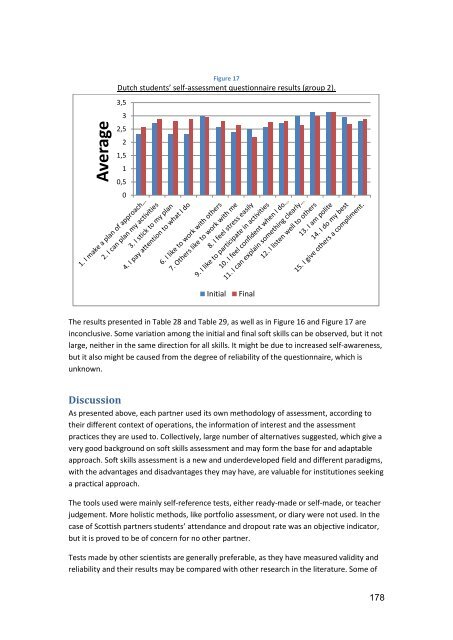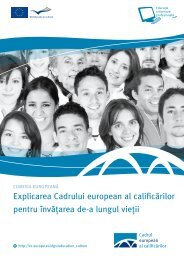Teaching and Assessing Soft Skills - MASS - Measuring and ...
Teaching and Assessing Soft Skills - MASS - Measuring and ...
Teaching and Assessing Soft Skills - MASS - Measuring and ...
Create successful ePaper yourself
Turn your PDF publications into a flip-book with our unique Google optimized e-Paper software.
Average<br />
Figure 17<br />
Dutch students’ self-assessment questionnaire results (group 2).<br />
3,5<br />
3<br />
2,5<br />
2<br />
1,5<br />
1<br />
0,5<br />
0<br />
Initial Final<br />
The results presented in Table 28 <strong>and</strong> Table 29, as well as in Figure 16 <strong>and</strong> Figure 17 are<br />
inconclusive. Some variation among the initial <strong>and</strong> final soft skills can be observed, but it not<br />
large, neither in the same direction for all skills. It might be due to increased self-awareness,<br />
but it also might be caused from the degree of reliability of the questionnaire, which is<br />
unknown.<br />
Discussion<br />
As presented above, each partner used its own methodology of assessment, according to<br />
their different context of operations, the information of interest <strong>and</strong> the assessment<br />
practices they are used to. Collectively, large number of alternatives suggested, which give a<br />
very good background on soft skills assessment <strong>and</strong> may form the base for <strong>and</strong> adaptable<br />
approach. <strong>Soft</strong> skills assessment is a new <strong>and</strong> underdeveloped field <strong>and</strong> different paradigms,<br />
with the advantages <strong>and</strong> disadvantages they may have, are valuable for institutiones seeking<br />
a practical approach.<br />
The tools used were mainly self-reference tests, either ready-made or self-made, or teacher<br />
judgement. More holistic methods, like portfolio assessment, or diary were not used. In the<br />
case of Scottish partners students’ attendance <strong>and</strong> dropout rate was an objective indicator,<br />
but it is proved to be of concern for no other partner.<br />
Tests made by other scientists are generally preferable, as they have measured validity <strong>and</strong><br />
reliability <strong>and</strong> their results may be compared with other research in the literature. Some of<br />
178





